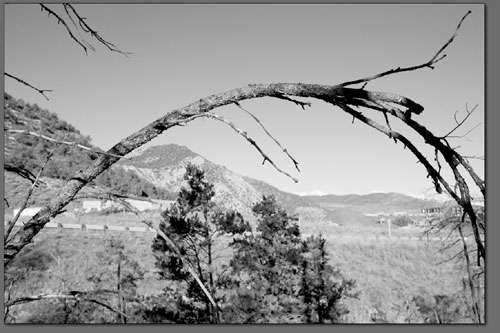|
| ||
| Rethinking the bark beetle SideStory: A local look at bark beetles: Southwest Colorado’s piñon hit hard by Ips beetle
by Will Sands They have been labeled an epidemic, a disaster and a scourge. However, bark beetles are also getting kinder treatment from a recent study. The findings relate that beetle-kill is actually a natural process, may not cause catastrophic wildfire and could actually benefit Colorado’s forests. Extensive bark beetle outbreaks are occurring is several Western states, including Colorado, and devastating populations of numerous species of trees. The number and intensity of the outbreaks prompted an independent group of scientists from Colorado State University, the University of Colorado and the University of Idaho to take a deeper look at the bark beetle. “The impetus for our study was our observation that there have been a tremendous number of insect outbreaks across the West in recent years,” said Bill Romme, CSU professor of fire ecology and the lead researcher. “Lifetimes can go by without much beetle kill, so the recent trends are very significant.” The intent of the study was to provide forest managers and policymakers with a foundation for handling beetle outbreaks and managing changing forests. However, the findings are also challenging current beliefs about beetle-kill. “It’s conventional wisdom that when insects kill a lot of trees, that sets the stage for catastrophic wildfire,” Romme said. “But we’re finding that’s probably not true.” On the contrary, fire risk is actually diminished after beetle kill trees drop their needles, according to the study. The risk may jump again in 10 to 20 years, but catastrophic wildfire is actually not as likely in dead stands without needles. Romme added that the beetles are also providing a natural check for overly dense forests and doing necessary thinning that is beyond the financial means of the U.S. Forest Service. In addition, bark beetles are native organisms that coexist with the trees, often in a symbiotic relationship. “Most of the outbreaks we’re seeing are natural processes,” Romme explained. “These are native insects, and these kinds of outbreaks have happened in the past and will happen again in the future. It’s part of the normal forest dynamic.” That said, Romme added that some current trends are not part of the normal forest dynamic. Specifically, higher-than-average temperatures challenge trees and encourage beetle growth and may be responsible for the ferocity of much of the West’s beetle kill. Romme pointed to a drought in the 1950s, where there was actually lower moisture content than currently exists. However, courtesy of lower temperatures, the bark beetle outbreak was actually much lighter. “We suspect that the warmer-than-normal temperatures are playing a big role in the outbreaks that we have now,” he said. “Higher temperatures make it harder for trees to defend themselves and lead to a faster growth of the bugs.” The bark-beetle study definitely has public lands managers talking and its findings are proving to be controversial. “There’s certainly not a lot of agreement from other researchers on the new conclusions,” said Dave Dallison, timber program leader for the San Juan National Forest. Dallison noted that the study’s analysis of fire danger and beetle kill is definitely ripe for discussion. “There’s a lot of debate about beetle kill and fire danger,” he said. “As the trees die and their crowns are red, there is extreme danger. I agree that once the needles fall, the actual risk of crown fire is reduced. But then you have heavy fuel build up, and 15 to 20 years down the road you have severe fire danger again.” However, Romme also stressed the report is purely an analysis of the bark beetle problem and not a call to simply let nature take its course, as some have alleged. “Our report talked only about the science of insect outbreaks and fires,” he said. “Some people have misinterpreted the report to think we advocate no action. That’s not the intent. We want our report to present neutral facts from which land managers can formulate appropriate actions.” However, formulating appropriate actions also presents a challenge for land managers, according to Dallison. “You really can’t control the spread of the epidemic once it’s established,” he said. “Really all you can do is practice good forest management and keep the stands thinned by a variety of means. When we have high-density forest and a drought situation, we’re predisposed to bark beetles. Our best defense is a good offense.” •
|
In this week's issue...
- May 15, 2025
- End of the trail
Despite tariff pause, Colorado bike company can’t hang on through supply chain chaos
- May 8, 2025
- Shared pain
Dismal trend highlights need to cut usage in Upper Basin, too
- April 24, 2025
- A tale of two bills
Nuclear gets all the hype, but optimizing infrastructure will have bigger impact


